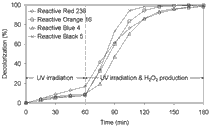Decolorization and Mineralization of Reactive Dyes, by the H2O2/UV Process With Electrochemically Produced H2O2
Keywords:
Decolorization, hydrogen peroxide, reactive dyes, in-situ H2O2, AOP, Reactive Red 238Abstract
Decolorization of Reactive Red 238, Reactive Orange 16, Reactive Black 5 and Reactive Blue 4 was studied in the UV/H2O2 process with H2O2 being produced electrochemically. The experimental results show that decolorization increased considerably when switching on the electrochemical production of H2O2. Complete decolorization (>99%) was achieved for all dyes under the applied experimental conditions, partial mineralization (49–85%) was obtained, which depends on the type of dye. Reactive Red 238 was used to investigate operational parameters and it was found that decolorization was influenced by the applied electrical current of the electrochemical cell and flow rate. Decolorization and mineralization of Reactive Red 238 can be described by pseudo-first order kinetics. It was found that the initial concentration of Reactive Red 238 has a negative influence on the pseudo-first order reaction constant.

Downloads
Published
Issue
Section
License
Except where otherwise noted, articles in this journal are published under the Creative Commons Attribution 4.0 International License
